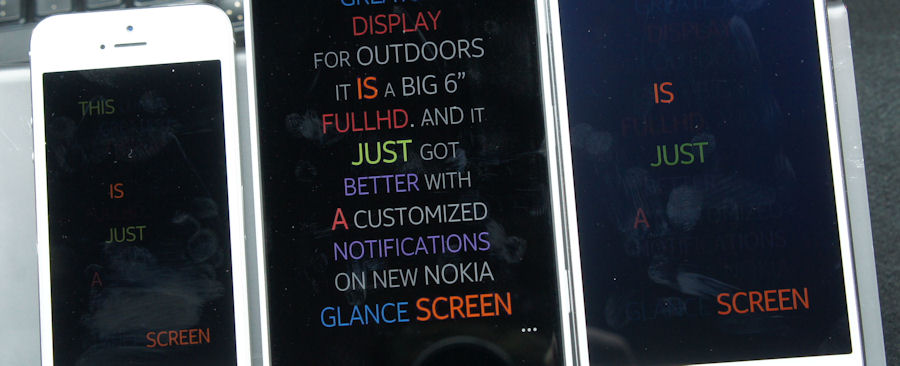Sunlight readability enhancement mode, which was first seen on the Nokia Lumia 920, tunes (adjusts) the way content is shown on the screen in response to what is being displayed (content) and changing lighting conditions (context). Together with Nokia's high brightness mode (increases luminance of screen by 20% in sunny conditions) and ClearBlack Display (reducing screen reflectance) technologies, it means that the displays on Nokia's higher end Lumia products are generally easier to see in bright sunlight than competing devices.
The downside of Nokia's original implementation of the sunlight readability enhancement mode technology was that, in very bright sunlight, the screen could appeared washed out. That was still much better than not being able to see the content at all, but did mean, in most circumstances, that screen performance outdoors did not match screen performance indoors. The reason? The display tuning was based on assessing screen content as a whole, which meant an average setting was applied across the screen. This limited the effectiveness of the display tuning, especially when viewing contrasting screen content (e.g. a photo with both light and dark areas).
With the Lumia 1520, Nokia is introducing the next generation of the sunlight readability enhancement technology. The big difference is that the display is tuned on a pixel by pixel basis, rather than the whole screen being treated as a whole. The biggest difference is when viewing content on the screen that has contrasting areas of dark and light, as shown in the video below. As with the original version, the impact of the technology is most apparent in bright sunlight, but because the screen is essentially better optimised the benefits are not only greater, but are also noticeable in a wider range of lighting conditions (including bright indoor lighting).
The video below shows how the updated technology was demonstrated at the recent Nokia World event. A series of adjustable overhead lights were used to simulate bright sunlight conditions. The first section of the video shows how certain colours can "disappear" from a screen in bright sunlight, while the second portion shows how a photo, with contrasting dark and light areas, can lose a lot of detail when seen in the sunlight. The Nokia Lumia 1520 is shown alongside the iPhone 5 and the Samsung Galaxy S4 (both known for having decent displays). The results are really quite startling, with the Lumia 1520 being very obviously superior.
We've seen a lot of demos at phone launch events and this demonstration of screen visibility in bright sunlight was one of the most impressive we've seen in the last few years. It's relatively unusual to see such a stark contrast when comparing high end smartphones. It is very evident that Nokia has a clear advantage here. It may not be quite akin to the advantage the Lumia 1020 camera module has over other lesser cameraphones, but honestly it's not that far off - and really needs to be seen to be believed.
Assertive Display - the tech behind sunlight readability enhancement mode
So what's the technology behind sunlight readability enhancement mode? As we mentioned in an earlier story, the Lumia 1520 is the first Nokia device to use Apical's Assertive Display technology and it is this that lies behind Nokia's improved sunlight readability enhancement mode. It takes the form of a module (semiconductor IP core) included with the Qualcomm Snapdragon 800 SoC (System-on-a-Chip) that powers the Lumia 1520.
The Assertive Display module takes control of both the screen brightness and the color of each individual pixel displayed on the screen, based on models of how the display and the human eye respond to the displayed content and the viewing environment.
The Assertive Display module is included in the display pipeline (the connection between the SoC and the screen) and continually tunes, in real time, what is being displayed on screen, based on input from the ambient light sensor and the pixel-by-pixel content of the screen. Apical says that this requires no additional CPU or memory load and consumes only a very small amount of power. Moreover, the tuning means that displays can typically use slightly lower backlight levels, which means that an Assertive Display-enabled devices typically consume at least 30% less display power than a normal device.

Nokia Lumia 1520 screen (centred) compared to iPhone 5 (left) and Samsung Galaxy S4 (right)
